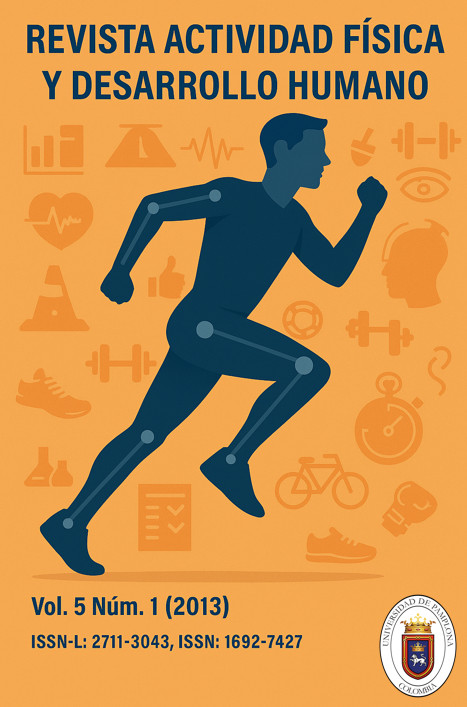La Universidad de Pamplona como institución facilitadora y orientadora de la actividad deportiva y recreativa (estudiantes, docentes y administrativos)
DOI:
https://doi.org/10.24054/afdh.v5i1.1690Palabras clave:
Actividad Física, Programa, Salud, Índice de masa corporal, DiagnósticoResumen
La Organización Mundial de la Salud (OMS), confirma que las Enfermedades Celebro Vascular (ECV) son la principal causa de muerte en todo el mundo. Cada año mueren más personas por ECV que por cualquier otra causa. Se calcula que en 2008 murieron por esta causa 17,3 millones de personas, lo cual representa un 30% de todas las muertes registradas en el mundo; 7,3 millones de esas muertes se debieron a la cardiopatía coronaria, son muchos los factores los que pueden incidir en el aumento de las ECV, uno de ellos posiblemente puede ser la poca cultura al ejercicio físico. Las personas que realizan un trabajo sedentario, que implica poca actividad física, tienen una peor condición neuromuscular, lo que puede aumentar el padecimiento de las ECV. Por este motivo se realizó en la Universidad de Pamplona un estudio donde se diseñó y se aplicó un programa de Actividad Física, en una población de 18 a 55 años, docentes, estudiantes y administrativos a los cuales se les realizo varios diagnóstico para conocer los niveles de actividad física, IMC, % graso, presión arterial, peso y talla llevándoles un control personalizado, obteniendo favorables resultados.
Descargas
Referencias
Arias Herrera, Héctor (1995). La comunidad y su estudio. Personalidad, educación, salud. Ciudad Habana. Editorial Pueblo y Educación. 97 p.
Barbero, J. M. y Cortés, F. (2005) Trabajo Comunitario, organización y desarrollo social. Madrid: Alianza Editorial.
Burnham, J.M. (1998).Exercise is medicine: health benefits of regular Physical activity. J-la State -Med-Soc. 1998 Jul; 150 (7). 319-23.
Casimiro, A.J. (2000). Educación para la salud, actividad física y estilo de vida. Universidad de Almería. Servicio de Publicaciones.
Cooper, D.M. (1994). Evidence for and mechanisms of exercise modulation of growth: an overview. Medicine and science in sports and exercise; 26,6:733-740.
Corbin, C.B. (1987). Youth fitness, execise and health: There is much to be done. Research Quartely for Exercise and Sport. 58, 4, 308-14.
Del Sol, F. (2000). Evaluación de un programa adaptado de educación física en niños y niñas de siete años en el ámbito de la salud. Tesis Doctoral. Universidad de Granada.
Devis, J. y Peiró, C. (1992). Nuevas perspectivas curriculares en educación Física: la salud y los juegos modificados. Barcelona: INDE.
Guerra Alfonso, Alaine (1999) Diseño de un programa de actividades deportivas recreativas para una comunidad rural. Trabajo de diploma Sancti Spíritus.
Rodríguez, F. A. (1995). Prescripción de ejercicio para la salud (I) Resistencia Cardiorrespiratoria. Apuntes: Educación Física y Deportes 1995(39) 87- 102.
Sánchez Bañuelos, F. (2000). La Educación Física orientada a la creación de hábitos saludables. Granada. Grupo Editorial Universitario y Sector de Enseñanza de CSI- CSF
Descargas
Publicado
Número
Sección
Licencia
Derechos de autor 2013 ACTIVIDAD FÍSICA Y DESARROLLO HUMANO

Esta obra está bajo una licencia internacional Creative Commons Atribución-NoComercial-SinDerivadas 4.0.











